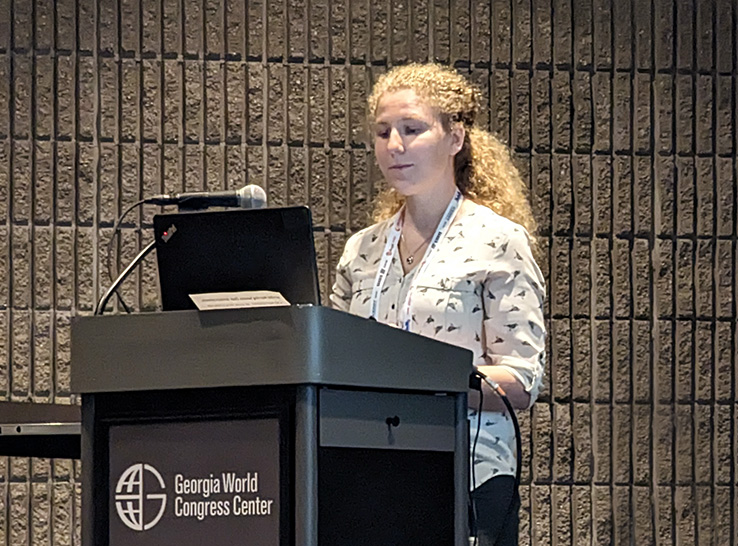Minimizing bird stress is critical for maintaining good welfare and flock performance, but it’s especially critical when birds are less than 4 weeks old, a Virginia Tech study shows.
“Our results confirmed that stress impacts tend to decrease with age,” reported Alexandra Ulans, graduate student at Virginia Tech, at the 2024 International Poultry Scientific Forum.
“The period up to 4 weeks of age is a particularly vulnerable time. We recommend that producers try to limit stressors during this period to potentially improve the broilers’ well-being, supporting better performance and welfare.”
Comparing strains and environmental factors
Ulans and colleagues investigated differences in chronic stress between bird genetic strains and environments to uncover new knowledge that could support improved welfare outcomes.
“Broilers have been genetically selected for faster growth, resulting in increased risk of poor welfare outcomes,” Ulans explained. “Potential solutions for these outcomes may be to use slow-growing broilers, provide the birds with a more complex environment or both.”
The researchers defined animal welfare as the bird’s ability to cope with its environment, composed of three parts: health and functioning, natural living and affective state. They designed their study to focus on affective state, which involves many parts based on emotions influencing moods.
“Emotions are an intense short-term response to a specific stimulus,” Ulans explained. “Emotions make up moods, which are less intense and longer-lived. Moods make up an affective state, which can last weeks or months.”
“Because broilers live 6 to 7 weeks, we can look at their entire emotional experience over this period by analyzing their affective state.”
Exploring key differences
Previous studies had reported that using slower-growing broilers can result in reduced cull rates, mortality rates and myopathies compared to using fast-growing broilers. Slower-growing broilers also display more active natural-maintenance behaviors than their fast-growing counterparts.
Studies with fast-growing broilers have also shown that high-complexity environments can be associated with reduced leg issues and footpad dermatitis, reduced fearfulness and increased natural behaviors, learning ability and optimism.
However, Ulans noted that differences between these two strains in different environments, in relation to chronic stress manifested in their affective state, have been relatively understudied.
“Our focus was to provide more knowledge in this area by looking into differences in chronic stress between fast- and slower-growing broilers raised in high- or low-complexity environments. We also wanted to learn more about how age and weight gain impact chronic stress.”
Mixed findings
The researchers designed the study to measure chronic stress by examining feather corticosterone levels, a known stress indicator.
“When a bird interacts with a stressor, the hypothalamic-pituitary-adrenal axis releases corticosterone into the bloodstream, which results in more corticosterone deposited in the feathers as the bird grows,” Ulans explained.
“Having a higher feather corticosterone concentration indicates more chronic stress experienced.”
For the study, 600 fast-growing birds (Ross 708) and 600 slow-growing birds (Hubbard Redbro) were raised in 24 pens with standard (low complexity) or complex (permanent and temporary enrichments) environments, resulting in six replicates per treatment.
As birds gained weight, feather corticosterone levels decreased. Fast-growing birds at 1 kg showed higher corticosterone levels than slow-growing birds at 2 kg and fast-growers at 3 kg. Slow-growing birds in a simple environment had lower feather corticosterone levels than slow-growing birds in a complex environment.
“We had hypothesized that slow-growers would show reduced feather corticosterone levels compared to fast-growers because of their improved health and ability to express behavior,” Ulans said.
“The slow-growers may have been worse at adapting to housing conditions than the fast-growers, as the genetic selection of fast-growers may have unintentionally resulted in improved adaptation and docility.”
The researchers also hypothesized that complex environments would reduce feather corticosterone concentrations, as this would stimulate the expression of natural behavior.
Increased vulnerability at early growth stage
Among weight and age results, the researchers found further evidence that early life may be more stressful than later life regardless of strain or environment, stabilizing in week 5.
Fast-growers experienced more chronic stress at 1 kg than slow-growers, which decreased as they gained weight. Slow-growers consistently experienced less chronic stress than fast-growers, except when comparing 1-kg slow-growers with 3-kg fast-growers.
Overall, the researchers found that corticosterone tended to decrease with age. “This is why we arrived at our recommendations for producers to try and limit stressors when the birds are less than 4 weeks of age.”
When raised without enrichments, fast-growers experienced somewhat more chronic stress than slow-growers, Ulans noted. “However, we found a weak impact of complexity, depending on strain.”





